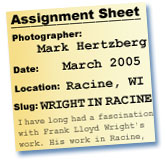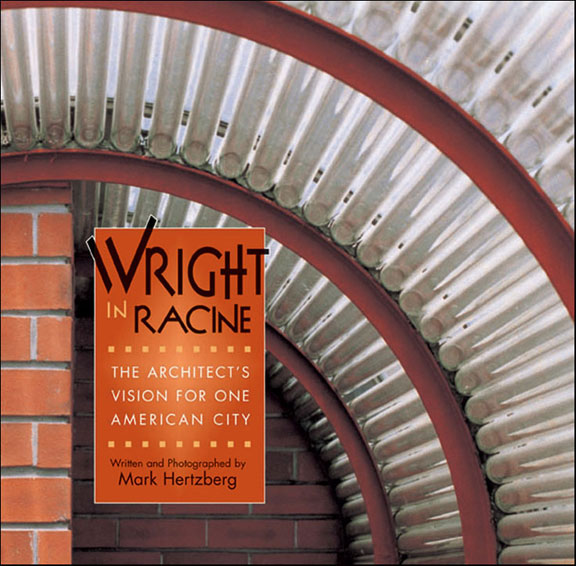WRIGHT IN RACINE
By Mark Hertzberg
Director of Photography
Journal Times (Racine, WI)
I was one of the original contributors to the Behind the Viewfinder web
project, from which 'Assignment Sheet' evolved (www.digitalstoryteller.com/YITL).
The project, which was started by Fritz Nordengren after Princess Diana's
death in 1997, was a forerunner of today's 'blogs.' I enjoyed the chance
to write regularly about my work, and the work of our staff, for YITL. Although
writing journals for the site gave me a chance to think about our daily routine
in a different way, my interest in writing about my work had waned by the
time Behind the Viewfinder wound down in 1999
.
My friend Dick Kraus, who started ‘Assignment Sheet’ as a way
to keep the project going, has been asking me for contributions to the 'Assignment
Sheet' for a few years, and I have let him down. This is my first journal
in several years. It is about an evolution in my work, from photo director
and photographer, to author of a book, and it ends with an ironic note about
how some people who are not familiar with my newspaper work, look at my photography.
I have a fascination with Frank Lloyd Wright's work. His work in Racine,
where I live and work, includes some particularly significant Wright commissions.
The best known is the landmark SC Johnson Administration Building (1936)
with the famous soaring dendriform columns in the Great Workroom.
| I researched, photographed,
and wrote several lengthy feature stories for The Journal Times
about Wright's work several years ago. The first was about what
is involved in the stewardship of a Wright building. My subject
was the SC Johnson Research Tower (1944), which the company vacated
in 1982, but still maintains as a corporate icon. AP picked up
the package, and I was delighted when someone told me that I got
a full page in the Baltimore Sun with both my story and my photos.
I am used to seeing my byline under photographs, so it was exciting
to see my byline as the writer on a full page feature in a metro
paper. |
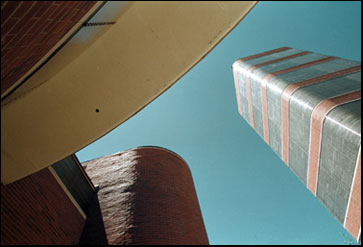
Photo © Mark
Hertzberg
Frank Lloyd Wright's SC Johnson Administration Building
and Research Tower present a myriad of shapes of concrete,
glass, and Cherokee red brick. |
|
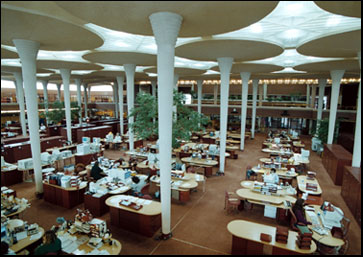
Photo © Mark
Hertzberg
The dendriform columns and Wright-designed desks are among
the highlights of the Great Workroom in the Frank Lloyd
Wright - designed SC Johnson Adminstration Building, which
opened in 1939. |
|

Photo (© Mark
Hertzberg
The Frank Lloyd Wright-designed SC Johnson Administration
Building and Research Tower at dusk, Thursday August 16,
2001 |
|
As I researched Wright's
work in Racine, I realized that his built and unbuilt work here
represents almost every significant stage of his career after 1900.
I was asked to tie the work together in a PowerPoint slide show for the Racine
Heritage Museum in 2002. The museum talk has evolved into a presentation
which I have had the privilege of giving at Talieisin, Wright's beloved home
in Spring Green, Wisconsin as well as at a number of other Wright sites and
conferences; at the Chicago Architectural Foundation; and to many local groups
.
While Wright's work here is significant, no one had made his built and unbuilt
Racine work the focus of a book. One day at work I was staring at a mouse
pad with a Wright design, and decided to write to Pomegranate, which published
the mouse pad and is the leading publisher of Wright books, note cards, etc.,
with a proposal for such a book. I sent them a disc with my slide show in
the spring of 2003.
Pomegranate invited me to submit a writing sample and an outline. I wrote
part of a sample chapter on my laptop in July...which, for an avid cyclist,
means that I was as busy checking the latest Tour de France results as I
was thinking about Frank Lloyd Wright’s legacy in Racine. My wife,
Cindy, and I came back from a cycling vacation in Canada in early August,
and were ecstatic to find an e-mail outlining a proposal for "Wright
in Racine," a 96 page book, with 12,000 words and 63 photos. The challenge
was that I would have just four months to research and write the text, for
release in September, 2004. In reality I had only three months to finish
the book, because people who had granted me
access to private archives wanted to read the relevant portions before I
submitted the manuscript to the publisher. I had almost all the photos I
needed, so I could concentrate on the text. Cindy graciously said she understood
that all fall I would be working at two jobs, my 'day job' at the newspaper,
and on the book.
|
© Photo by Aaron Hertzberg
The book's title is on the shipping cartons.
|
The Acknowledgements in the book are lengthy because so many people were generous
with their time, with their memories, with critiques, and with leads on where
to find material. My manuscript passed muster at the local archives, and
Cindy and I went out to dinner to celebrate after dropping the manuscript
off at FedEx on December 2.
Shannon Lemme of Pomegranate did a magnificent job with the cover design , and
Eva Strock painstakingly went through my copy. The contract had called for 12,000
words; I sent 20,000 and Eva kept them all. |
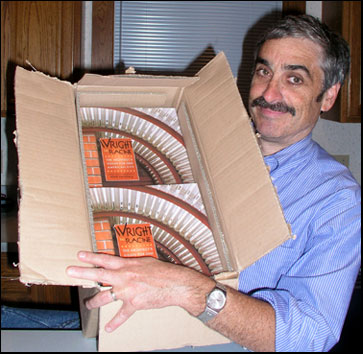
© Photo by Aaron Hertzberg
The author unpacking the first shipment of books... |
|
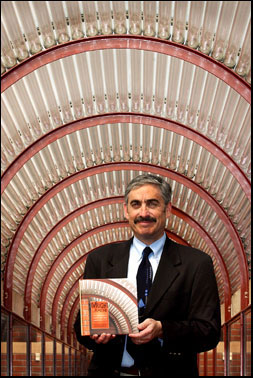
| © Gregory Shaver The Journal Times |
|
I
remember the anticipation of seeing my first published photo,
in 1967 in a weekly newspaper in Princeton, NewJersey (it was
a photo of a Princeton-Navy lacrosse game). I had the same feeling
last July when I got an advance copy of the book.
There was an irony in the production of the book that underscores that I had
moved to a new chapter in my career, as much as I still enjoy my work at the
newspaper. The first proof of the book cover had my name as the author, but said
nothing about who had shot the photographs. |
I
have made my living as a photojournalist for more than 30
years, but when someone who saw an early draft said he was
surprised that I took such good pictures for a writer, I asked
Shannon to include the words" written and photographed
by" Mark Hertzberg in her cover design. |
|
‘Wright in Racine’ is sold at museums and Wright-related
gift shops, as well as at a variety of bookstores and on the
Internet. It has sold well. I am continuing my research on other
Wright projects.
Mark Hertzberg
hertz@wi.net
|
